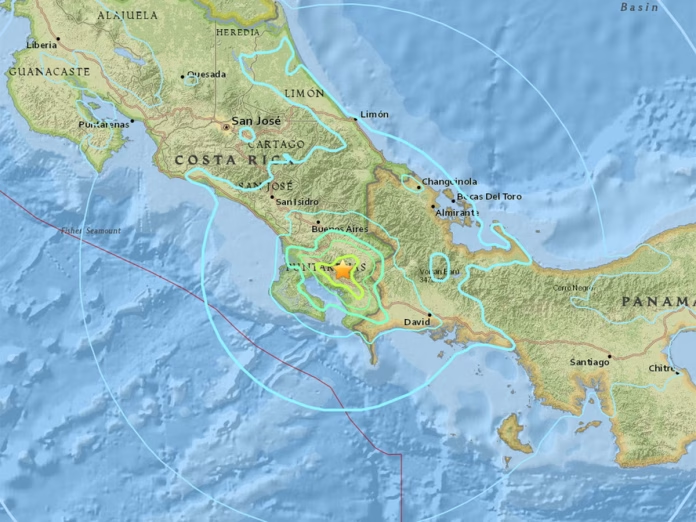The border region between Panama and Costa Rica has experienced a notable geological event: a magnitude 5.7 earthquake shook the area, raising concerns among residents and local authorities. This earthquake has drawn attention to the region’s seismic activity and its potential implications for nearby communities.
What We Know About the Panama-Costa Rica Earthquake
The United States Geological Survey (USGS) reported that the earthquake occurred on July 22, 2024, at 13:19:34 (UTC-06:00). Its epicenter was approximately 5 km (3.1 miles) southeast of Puerto Armuelles, located in Panama’s Chiriquí province near the Costa Rica border.
The earthquake, with a magnitude of 5.7, falls into the category of moderate to strong events, capable of causing damage to structures and posing risks to human safety.
Key Details About the Earthquake:
- Magnitude: 5.7 on the Richter scale
- Focal Depth: 3 km (1.9 miles)
- Location: 8.233°N, 82.841°W
- Time: 2024-07-22 13:19:34 (UTC-06:00)
Impact of the Earthquake
The effects of this seismic event were felt in both countries, with reports coming from various locations near the border.
Immediate Consequences:
- Structural Damage: Minor to moderate damage was reported in some buildings near the epicenter.
- Power Outages: Localized electricity interruptions affected several communities.
- Communication Problems: Temporary disruptions were experienced in some cellular networks.
Response to the Earthquake
Authorities in both Panama and Costa Rica mobilized emergency response teams to assess the situation and provide assistance where needed. The Pan American Health Organization (PAHO) is monitoring the situation and coordinating with local health authorities to ensure adequate medical response if required.
Understanding the Earthquake: Geological Context
The earthquake occurred in a region known for seismic activity due to its location along the Pacific Ring of Fire. This area is characterized by the interaction of several tectonic plates, including the Cocos Plate, the Caribbean Plate, and the Nazca Plate.
Tectonic Configuration:
- Subduction Zone: The Cocos Plate is subducting beneath the Caribbean Plate.
- Fault Lines: Several active fault systems traverse the region.
- Seismic History: The area has a record of significant earthquakes.
Aftershocks and Continued Risks
Following the main earthquake, multiple aftershocks were recorded. These secondary tremors are a normal part of the seismic process but can pose additional risks to already weakened structures.
Aftershock Activity:
- Number of Aftershocks: One recorded as of 2024-07-22 19:19:34 (UTC)
- Magnitude Range: Up to 5.9 on the Richter scale
Safety Measures and Preparedness
In light of this earthquake, local authorities are urging residents to take necessary precautions and prepare for potential additional seismic activity.
Recommended Actions:
- Stay Informed: Monitor local news and official sources for updates.
- Emergency Kits: Prepare or review existing emergency supplies.
- Evacuation Plans: Familiarize yourself with evacuation routes and safe meeting points.
- Structural Safety: Inspect buildings for damage, especially older structures.
The International Federation of Red Cross and Red Crescent Societies (IFRC) provides valuable resources on earthquake preparedness and response, which may be useful for residents in affected areas.
Economic Implications of the Earthquake
While it is too early to assess the full economic impact, the earthquake could have implications for local and regional economies:
- Infrastructure Damage: Costs of repairing affected buildings and roads.
- Tourism Impact: Potential short-term effects on the tourism industry.
- Business Disruptions: Temporary closures and productivity losses in the earthquake zone.
Long-Term Seismic Outlook for the Region
This earthquake serves as a reminder of the ongoing seismic risks in the region. The Seismological Society of America emphasizes the importance of continued research and monitoring to better understand and prepare for future seismic events in this geologically active area.
Stay Alert: Updates on the Panama-Costa Rica Earthquake
As the situation continues to develop following the magnitude 5.7 earthquake on July 22, 2024, it is crucial for residents, visitors, and authorities to remain vigilant and prepared. This seismic event underscores the importance of earthquake preparedness in regions prone to such natural disasters.
For continuous updates on the Panama-Costa Rica earthquake, its aftermath, and expert analyses of the region’s seismic activity, visit morsilla.com. Our commitment is to provide accurate and timely information to help you stay informed and safe in the face of natural disasters.



